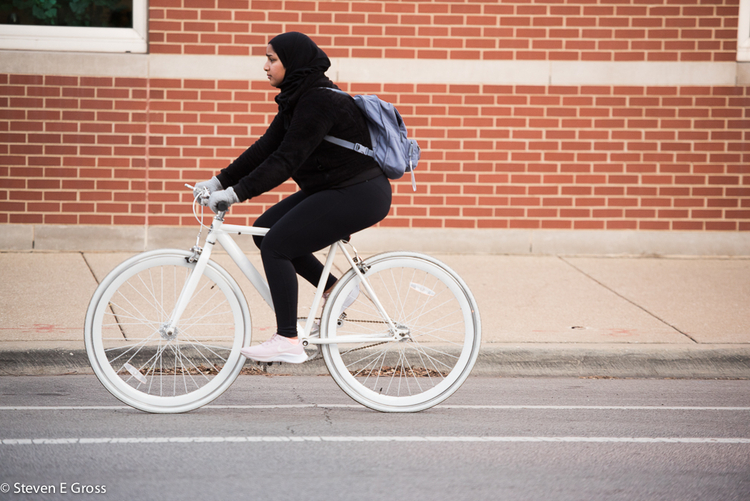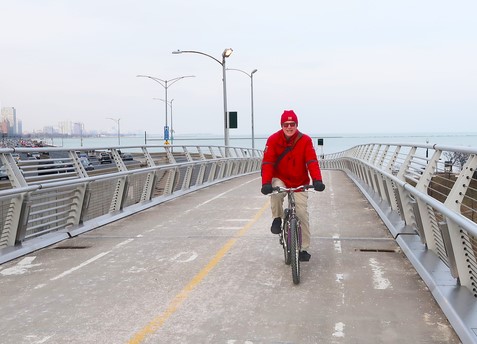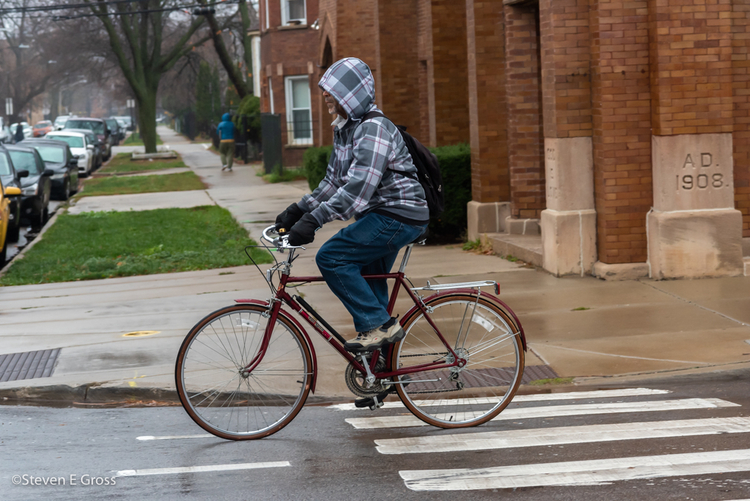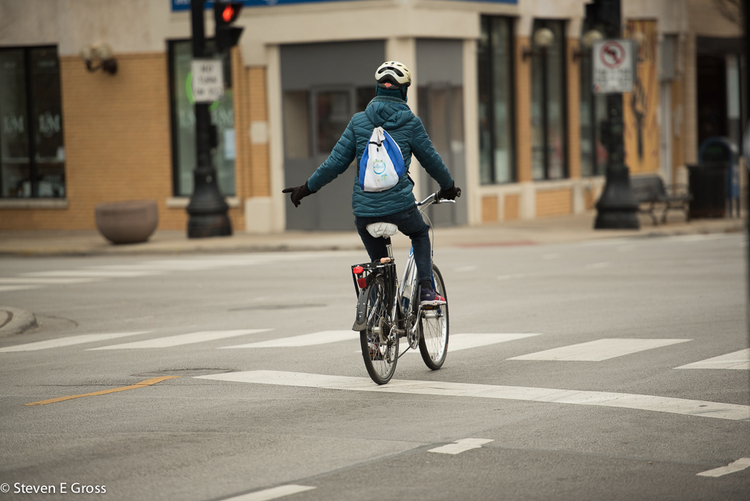Braving the Chicago winter on a bicycle may seem like a daunting prospect. But there’s no need to hang up your bike when the cold weather arrives.
With proper preparation, some extra gear, and the right attitude, you can navigate the city’s streets on two wheels like a seasoned winter rider.
Here are some tips and tricks for a safe, enjoyable winter biking experience.
WHAT TO WEAR
Many cyclists often wonder what clothing to wear when biking in the winter. Riding in cold weather is all about layering. A three-layer approach provides the flexibility, warmth, and comfort you need. It allows you to trap body heat between multiple layers while also letting you add or remove layers to adjust to changing weather conditions and temperatures.
For the base layer, choose a thin fabric that wicks away sweat and moisture, such as polyester or wool. Avoid cotton. The fabric absorbs water and keeps it close to your body, which can make you feel clammy and cold.
Wear a loose, warming middle layer made of merino wool, fleece, or synthetic fibers that suits your personal style and comfort. They retain heat without bulk and are naturally breathable and odor resistant.

The outer layer should consist of a jacket or coat that is wind resistant as well as waterproof or water resistant. Outer shells with zippers and vents allow you to adjust the jacket or coat as you get warmer or colder. You may also want to consider wind-blocking pants or thicker tights for extremely cold weather.
For the head, wear a beanie or cap thin enough to fit under your helmet and that can protect your face and ears. Balaclavas cover most of the head and neck, but a combination of scarves, earmuffs, and hats provide more flexibility.
Extremities can be difficult to keep warm. Invest in waterproof boots that are about a half or full size larger than your normal feet size to accommodate thick socks (again, not cotton) and allow the toes to move. Protect your hands by wearing lobster gloves or layering mittens with glove liners. They provide warmth while allowing your hands the freedom of movement to maneuver brakes and shift gears.
When purchasing cycling clothes, don’t worry about buying gear specifically made for bicycling. As long as the clothing pieces are functional, you can get them at a thrift store or a big box store.
As you put together your bicycling outfit, keep in mind that you want to feel a little cold before you head out the door because you will warm up while riding. If you feel comfortable or warm in your cycling apparel before you even hop on your bike, you are likely overdressed and will perspire quickly once you are cycling.
Sweating in winter weather can get dangerously cold when you stop pedaling because the moisture will start to freeze and may pose a risk of frostbite.
BIKE GEAR

Winter weather can take a toll on your bike. Outfitting it with the proper gear and regularly maintaining it will keep your bike in good condition during the winter.
Lights are required by law. You need a headlight and taillight so you are visible to motorists at night and to illuminate the path in front of you. As an extra safety measure, consider applying reflective tape to your bike to enhance your visibility on the road.
While wider tires can provide stability, regular tires will work fine in winter — the exception is heavy snow of more than 3 inches.
To cut down on the moisture, dirt, mud, salty slush and other winter debris that lands on you and your bike, invest in a set of fenders. They help deter some of the road gunk from caking on your bike and splattering on your clothes.
To prevent grime and salt from corroding your bike and interfering with moving parts, wipe down your bike regularly and lubricate all moving parts, except brake pads. Some people clean their bike chains every couple of weeks during winter. Give your bike a full tune up at the beginning and end of the cold-weather season.
Some people who live in Chicago choose to use Chicago’s bike sharing program, Divvy, for winter biking. It’s a great option if you don’t own a bike or don’t want to ride your bike in the slush and salt that inevitably comes with winter. Some people choose this option simply because the Divvy e-bikes can hasten that cold weather trip!
RIDING TACTICS
After you’ve figured out your riding attire and bike gear, it’s time to develop some tactics on how to cruise around the city on two wheels safely and comfortably.
Plan your travel route and have alternate possibilities in mind. Main drags get cleared of snow first, but tend to be more crowded with motorists and other cyclists. Side streets may have more slush and snow, but they will be calmer and have less high-speed traffic.

When you encounter ice, hard-packed snow, and slick metal, stay loose, pump your brakes, keep your weight back, and go slow. If you do find yourself on something slick, don’t try to correct or brake. Just stop pedaling. Keep steady, and you’ll likely glide right over the icy patch.
Slow is the way to go. There’s no shame in riding slower and walking your bike when you need to. It takes time to develop the skills and confidence to master biking in wintry conditions. By practicing at your own pace and learning as you go, you’ll gradually become more comfortable with winter biking.
With these tips and suggestions at your disposal, you’ll be able to enjoy the perks of biking year-round. Don’t let another winter season pass by without at least trying winter biking.
________________________________________________________
MORE RESOURCES
- Wearing the right clothing is an important element of biking safely in the winter. Winter cyclists don’t need to purchase expensive specialized biking apparel nor sacrifice their personal styles to stay warm and comfortable. The key to braving the wind chill and snow on two wheels is to embrace layering and to wear clothes that offer both insulation and breatheability. Active Trans breaks down the dos and don’ts of winter biking apparel in this video “Dressing for Winter Biking (part 1).”
- When the temperatures start to plummet into the 30s and below, clothing is more important than ever in protecting winter cyclists. To keep the wind and cold at bay, cyclists need to step up their layering game with an extra layer or two while making sure they protect their extremities with waterproof and windproof apparel and accessories. Active Transportation Alliance goes into the details with this video “Dressing for Winter Biking (part 2).”
- Want some general biking tips? Check out the Active Trans Everyday Biking Guide.
This post was written by Jordan Bray, a communications intern at Active Trans.

